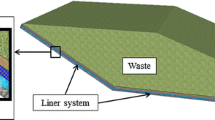Abstract
This paper presents the results of a comprehensive study that investigated the influence of asperities and roughness on the shear responses of geomembrane/geotextile interfaces. This study was aimed at providing a scientific explanation of the effect of surface texturing on geomembrane/geotextile interfaces shear behaviour as well as to recommend the quantification of asperity and roughness characteristics which mobilises optimised shear strength for the considered interface. The GMB/GTX interface shear tests were conducted according to ASTM D5321, under saturated conditions with the “305 mm by 305 mm” direct shear box at applied normal stresses of 25–400 kPa. The experimental outcome showed that the variation in geomembrane asperity height and surface roughness (from slightly textured to highly textured geomembranes) eventually mobilised an increase of 20° in the peak interface friction angle values. It was, however, observed that as the surface texturing was increased, more pronounced wear occurred which resulted in a relatively minimal increase of 6° in the large displacement friction angle. In addition, the geomembrane surface with asperity height of 1.2 mm and average surface areal roughness of 75 μm was observed to develop optimal peak friction angle for the considered geomembrane/geotextile interface. These observations were validated by means of post-shear deformation evaluation and it is anticipated that the findings presented herein would be useful in the design of geotechnical systems comprising of geomembrane/geotextile interface with enhanced stability and durability







Similar content being viewed by others
References
Yu Y, Rowe RK (2018) Development of geomembrane strains in waste containment facility liners with waste settlement. J Geotext Geomembr 46(2):226–242
Textile Center of Excellence, “Textile Innovation Knowledge Platform,” 2019. [Online]. Available: http://www.tikp.co.uk/knowledge/market-sectors/geotextiles/applications/. Accessed: 11-Jul-2019
Shukla SK, Yin JH (2006) Fundamentals of geosynthetic engineering. CRC Press
Sarsby RW (2006) Geosynthetics in civil engineering. Woodhead Publishing
Koerner RM (2012) Designing with geosynthetics-Vol.1. Xlibris Corporation
Bergado D, Ramana V, Sia I, Varun (2006) Evaluation of an interface shear strength of composite liner system and stability analysis for a landfill lining system in Thailand. J Geotext Geomembr 24(6):371–393. https://doi.org/10.1016/j.geotexmem.2006.04.001
Xuede Q (2008) Critical interfaces in geosynthetic multilayer liner system of a landfill. Water Sci Eng 1(4):22–35. https://doi.org/10.3882/J.ISSN.1674-2370.2008.04.003
Bacas M, Canizal J, Konietzky H (2015) Shear strength behaviour of geotextile/geomembrane interfaces. J Rock Mech Geotech Eng 7(6):638–645. https://doi.org/10.1016/j.jrmge.2015.08.001
Yesiller N (2005) Core thickness and asperity height of textured geomembranes : a critical review experimental case study. GFR 23(4):4–7
Adesokan D, Blond E (2018) Asperity height or asperity concentration : what matters more for interface shear resistance on textured polyethylene (PE) geomembranes ?. In 11th International Conference on Geosynthetics. 7.
Fowmes J, Dixon N, Fu L, Zaharescu C (2017) Rapid prototyping of geosynthetic interfaces: investigation of peak strength using direct shear tests. J Geotext Geomembr 45(6):674–687. https://doi.org/10.1016/j.geotexmem.2017.08.009
Zaharescu CA (2018) Wear Quantification of Textured Geomembranes using Digital Imaging Analysis. PhD Dissertation submitted to Loughborough University, United Kingdom.
Adeleke D, Kalumba D, Hardie P (2019) Effects of asperities on the geotextile-geomembrane interface shear characteristics. In: Acosta-Martínez HE, Lehane BM (eds) 13th Australia New Zealand Conference on Geomechanics. Australian Geomechanics Society, Perth, pp 699–703
Adeleke D, Kalumba D, Oriokot J (2019) Asperities effect on polypropylene & polyester geotextile-geomembrane interface shear behaviour. E3S Web Conf 92:5. https://doi.org/10.1051/e3sconf/20199213017
Adeleke D (2020) An Investigation into the Effects of Asperities on Geomembrane/Geotextile Interface Shear Characteristics. MSc Dissertation submitted to University of Cape Town, South Africa.
Chai J-C, Saito A (2016) Interface shear strengths between geosynthetics and clayey soils. Int J Geosynth Ground Eng 2(3):1–9. https://doi.org/10.1007/s40891-016-0060-8
Frost J, Lee S (1990) Microscale study of geomembrane-geotextile interactions. Geosyn Int 8(6):577–597
ASTM D5321 (2014) Standard test method for determining the shear strength of soil-geosynthetic and geosynthetic-geosynthetic interfaces by direct shear. ASTM Int 14(1):1–11
Uesugi M, Kishida H (1986) Frictional Resistance at Yield Between Dry Sand and Mild Steel. Japanese Society of Soil Mechanics and Foundation Engineering. 26(4):139–149. Available: https://www.jstage.jst.go.jp/article/sandf1972/26/4/26_4_139/_pdf.
Martinez A, Frost JD (2017) The influence of surface roughness form on the strength of sand–structure interfaces. Géotech Lett 7(1):104–111. https://doi.org/10.1680/jgele.16.00169
Dejong J, Frost J, Sacs M (2018) Relating quantitative measures of surface roughness and hardness to geomaterial interface strength. ISRM International Symposium 2000, IS 2000.
Acknowledgements
The research described in this paper has been supported by the financial contribution from the Geosynthetics Institute (GSI), Folsom, USA through the GSI Fellowship Grant. This support is gratefully acknowledged. In addition, appreciation is extended to the Mastercard Foundation Scholarship at the University of Cape Town for the robust financial assistance towards conducting the study. All the geomembranes and geotextiles used in this investigation were, respectively, provided by AKS Liner Systems (Pty) Ltd in Cape Town, South Africa and Fibertex South Africa (Pty) Ltd in Johannesburg, South Africa, for which the authors are most grateful.
Author information
Authors and Affiliations
Contributions
All the listed authors contributed to the manuscript’s development in a distinguishable manner. As the main supervisor and first co-supervisor, A/Prof Denis Kalumba and Ms Lita Nolutshungu supported the research conception, design, and experiments. Mr. Johnny Oriokot functioned as the second co-supervisor and provided technical insight to material selection and field application of geosynthetics. In addition, all geosynthetics roughness tests were conducted at the University of California, Davis, under A/Prof Alejandro Martinez’s supervision and direction. The manuscript’s first draft was written by Mr Daniel Adeleke and commented upon by all the other authors. All the authors read and approved the final manuscript.
Corresponding author
Additional information
Publisher's Note
Springer Nature remains neutral with regard to jurisdictional claims in published maps and institutional affiliations.
Rights and permissions
About this article
Cite this article
Adeleke, D., Kalumba, D., Nolutshungu, L. et al. The Influence of Asperities and Surface Roughness on Geomembrane/Geotextile Interface Friction Angle. Int. J. of Geosynth. and Ground Eng. 7, 20 (2021). https://doi.org/10.1007/s40891-021-00265-y
Received:
Accepted:
Published:
DOI: https://doi.org/10.1007/s40891-021-00265-y




